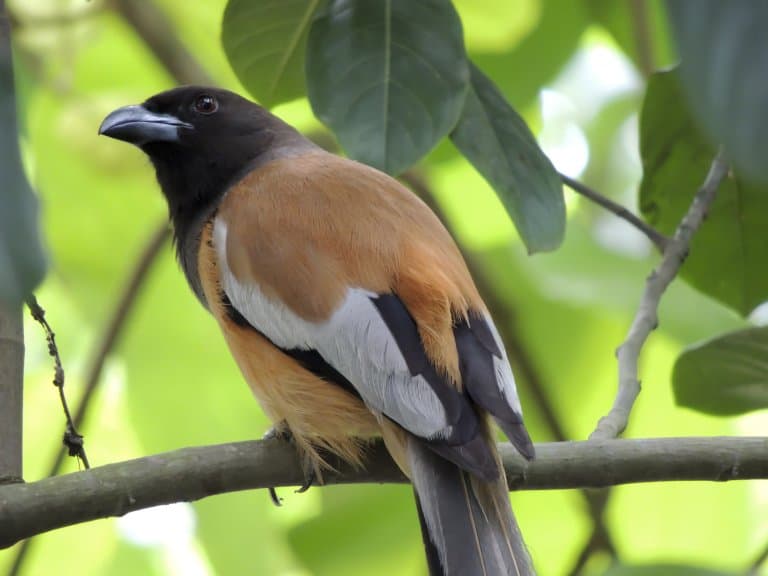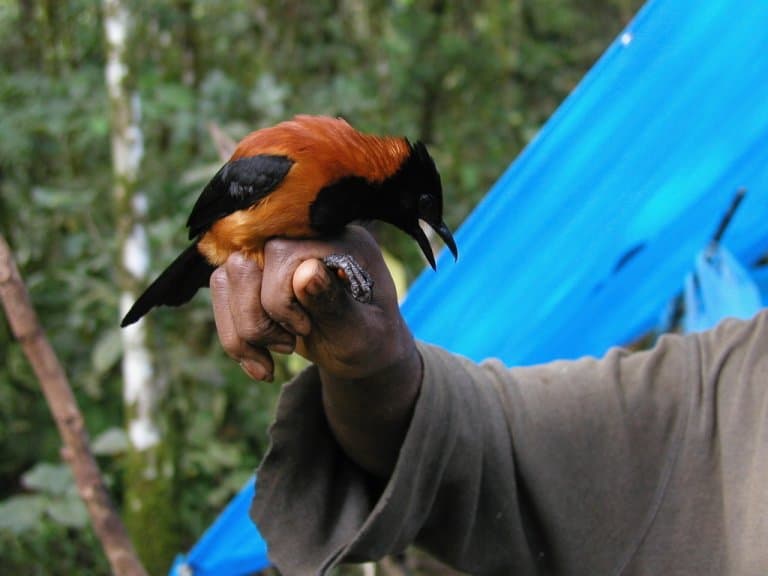Hooded Pitohui Profile
Poisonous animals are ubiquitous in the tropics. Amphibians, spiders, snakes and insects are well known for being a lucky dip of jungle danger.
But you’d be less inclined to caution when ruffling the feathers of a pretty little songbird, and if you were doing it in New Guinea, this might be at your peril.
The hooded pitohui is one of the few birds we know of that’s toxic. And it’s not only poisonous, it secretes one of the most notorious toxins of the animal kingdom.

Hooded Pitohui Facts Overview
| Habitat: | Forest, from ground to canopy |
| Location: | New Guinea |
| Lifespan: | Unknown |
| Size: | 23cm (9 inches) long |
| Weight: | 76g (2.7 oz) |
| Colour: | Rusty red with black wings and head |
| Diet: | Fruit, grass, seeds, insects |
| Predators: | Unknown |
| Top Speed: | Unknown |
| No. of Species: | 1 |
| Conservation Status: | Least Concern |
The hooded pitohui is as difficult to eat as it is to spell.
Its toxicity was long recognised by local hunters, who forgot to tell contemporary scientists, and so it was only recently written about in English as one of the very few toxic birds known.
Since then, people have been arguing about why it’s so toxic and have in some cases missed the forest for the trees.
Meanwhile, the trees of New Guinea are home to this exceptional bird, that has thrived in areas where many are still struggling.
Interesting Hooded Pitohui Facts
1. They make a lot of noise
These birds are cooperative breeders, which means they help each other out with the childcare roles.
There’s some suggestion that cooperative breeding leads to a more diverse or complex vocal repertoire than non-cooperative breeders (at least in corvids), and whether or not this is the case for the hooded pitohui remains to be seen, but they are said to have at least seven distinct calls.
And, as if it was any use to anybody at all, the calls of this species have been transcribed into text. So, here are some of them, in case you ever come across a book written in bird:
“tuk tuk w’oh tuw’uow”
“woiy, woiy”
“tiuw tow”
“hui-whui-whooee”.
Suffice it to say, you’re better off listening to it on Xeno-canto. 1 2

2. They form mixed species hunting parties
These large flocks of insectivorous birds from different species will join each other while foraging for food.
While it’s typically assumed that different species are in direct competition with each other for food in the animal kingdom, researchers believe that these larger flocks can help these birds gain access to more food for the party by driving insects out of hiding.
It’s also thought that a larger flock reduces the risk of being eaten by predators, who find it difficult to ‘single out’ one bird from many.
Hooded pitohui will often act as a flock leader in these hunting parties and while they diet on fruit predominantly, they will also eat insects such as beetles, spiders, caterpillas, as well as grass seeds.
3. They are poisonous
Perhaps more easily described with words is this species’ peculiar defense strategy. Hooded pitohuis are unusual among birds in their ability to produce a powerful toxin.
In fact, this is so rare that until recently only three species – all in the same genus – are known to do it. We now know that there is at least one other genus that has poisonous birds in it, but they’re still very uncommon.
Interestingly, the poison in the pitohui is well known to science, as it’s the same toxin found in poison dart frogs: batrachotoxin.
But these frogs live 10,000 miles away on another continent, so what’s the link?
When poison dart frogs are kept in captivity, they no longer secrete their dangerous toxins, suggesting they acquire this defence through something in their diet.
Beetles in the Choresine genus are the likely culprits, as species in this genus can be found in both locations and have been found in the stomachs of both the bird and the frog. 3

4. Toxicity is a spectrum
In this world of vague and ineffective dietary concepts like ‘detoxing’ it can be easy to lose sight of what certain things actually mean.
In biology, toxins are generally of biological origin, as byproducts of metabolism and cause some kind of harm to those that come in contact with them.
Toxins are usually produced as a defence against attack, but they exist on a huge spectrum from the injectable poisons of the deadliest octopus to the moderate infection risk of a human tongue, and even to the bitter flavour in our coffee.
But even for a toxin as infamous as batrachotoxin, it’s the dose that makes the poison.
Poison dart frogs are not nearly as delicious as they look, and acute intoxication from one of these tiny amphibians can quickly kill you.
In the pitohui bird, this same toxin gave researchers a bit of a numb sensation in their hands and is known to the locals to make the bird taste kind of gross. Not exactly as exciting as the monkey-killing poison of the dart frogs, but still the same molecule.
Still, due to their potential, they made our most poisonous animals in the world list.
5. This might be a parasite defense
While poison dart frogs have this toxin in abundance, these birds seem to have a more diluted concentration spread out over their feathers and tissues, explaining how the effects of exposure are so vastly different between the two.
This weakened version of the toxin has led some people to suggest it isn’t a predatory defence at all, and may in fact be more suited to parasite protection.
When investigated, certain parasites, like chewing lice, definitely showed a preference for the non-toxified feathers of the birds, lending credence to the speculation. 4
6. They can upset snakes
Sitting firmly in the predator-defence corner, researchers demonstrated more evidence that this bird is more than a match for its would-be predators.
The green tree python, a fascinating Asian analogue of the emerald tree boa from South America, is known for hunting birds, and when rudely assaulted with bird toxins, it’s shown to respond very negatively.
The toxins appear to irritate the throat of the snake, suggesting that this is something they may have evolved specifically to do. If that’s the case, there would be hard evidence that this toxin is a predator defence.
But if you remember for a moment that humans, too, are part of the ecosystem, the evidence becomes pretty conclusive.
Local hunters of songbirds have shared the island with its wildlife for over 60,000 years.
These are people who typically eat birds this size, yet are successfully deterred by the unpalatable taste of this particular toxic species.
This shows for certain that the toxin is an effective protection against predators, and at the same time, highlights the way we often consider humans somehow separate from the evolutionary history of the animals they share an ecosystem with. 5
7. Imitation is the sincerest form of flattery
And the success of this poison in doing whatever it’s supposed to do has led to a certain amount of mimicry in the bird’s ecosystem.
Evolution will always favour what’s optimal over what’s perfect, and if you can grow to look like something very dangerous, you might not have to put the resources into actually becoming dangerous yourself.
A hoverfly, for example, has no natural defences against bird predators but may look sufficiently like a bee or wasp that its enemies hesitate before chowing down on it.
This is known as Batesian mimicry and is a cheaper alternative to producing your own toxins. It’s thought to be the reason other, non-toxic songbirds share a similar colouration to the hooded pitohui.
However, other species have chosen to both mimic the colouration and match the toxicity, and this is known as Mülarian mimicry: a shared understanding of a very distinctive warning pattern.
But this also weakens the hypothesis that the toxins are used as a parasite deterrent since animals like chewing lice don’t have the visual system to select a host based on what they look like. A visual deterrent will only be useful against larger animals that are likely to hunt the birds.
As (almost) always, when there’s a debate about two likely possibilities, the likely truth is that both are true to some degree. 6
8. This has likely helped the species
The hooded pitohui, possibly as a consequence of its unpopular flavour, is doing quite well. It’s listed as of “least concern” by IUCN, and populations are thought to be stable.
Interestingly, even in disturbed habitats, the birds seem to be doing well; likely as a result of their varied diet and lack of predators.
Hooded Pitohui Fact-File Summary
Scientific Classification
| Kingdom: | Animalia |
| Phylum: | Chordata |
| Class: | Aves |
| Order: | Passeriformes |
| Family: | Oriolidae |
| Genus: | Pitohui |
| Species: | Pitohui Dichrous |
Fact Sources & References
- “Hooded Pitohui”, xeno canto.
- Walter Boles (2020), “Hooded Pitohui”, Birds of the World.
- “Hooded Pitohui: Overview & Facts”, Study.com.
- John P. Dumbacher (1999), “Evolution of Toxicity in Pitohuis: I. Effects of Homobatrachotoxin on Chewing Lice (Order Phthiraptera)”, Oxford Academic.
- John P. Dumbacher (2009), “Skin as a Toxin Storage Organ in the Endemic New Guinean Genus Pitohui”, Oxford Academic.
- John P. Dumbacher (2001), “Phylogenetic evidence for colour pattern convergence in toxic pitohuis: Müllerian mimicry in birds?”, The Royal Society.
